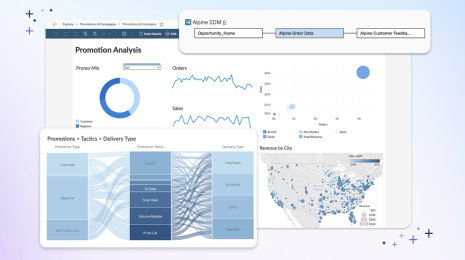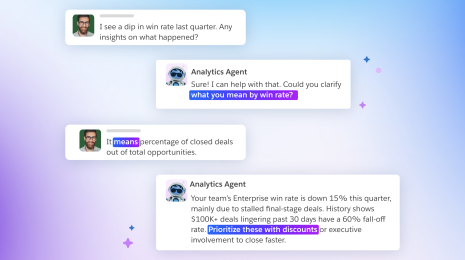The Uncomfortable Truth About Data-Driven Decisions (and How Agentic Analytics Will Fix It)
Let's be frank about data-driven decisions: For all the talk, they're simply not happening enough throughout far too many businesses. Organizations pour tremendous resources into collecting, connecting, and curating fragmented data across hundreds, even thousands, of data warehouses and lakehouses. Yet, despite this massive investment, a majority of employees don’t make decisions informed by that data. Why? Because data remains siloed. It gets overlooked. Or it's simply too time-consuming to sift through—especially when action needs to happen now.
Time and again, businesses are left data-rich, but insight-poor. So how do we finally change this landscape? How do we ensure your business truly gains the insights and takes the decisive actions you're looking for?
It starts with agentic analytics. This isn't just about making things run smoother; it's a fundamental paradigm shift designed to give you a critical edge by rethinking how work gets done and empowering your teams to do their best. Agentic analytics directly addresses the biggest challenges we see with data today: it unifies your data, builds trust in its insights, empowers your workforce to get answers fast, and most importantly, translates those insights directly into timely action.
This is how we unlock a new level of efficiency, agility, and competitive advantage for your business.
Unify your fragmented data for real-time insights
Let’s face it: the modern data landscape is fractured. Information is scattered across an ever-growing sprawl of on-premises systems and cloud applications. This fragmentation isn't just an inconvenience; it creates impenetrable silos that deny you a coherent, real-time view of your customers and your business. It's the silent killer of timely decisions, preventing your workforce from getting the insights they need, precisely when they need them.
This is why unified data is absolutely critical for the promise of agentic analytics to truly shine. Only by unlocking data trapped across your organization can you create that foundational data layer—a single, trusted view of your entire business. And this is the essential first step that empowers AI agents to deliver personalized, context-aware, and truly actionable insights across all your applications and workflows.
Build trust in data with consistent, shared language
Beyond the mess of disconnected data, another big problem is that people don’t trust the data they have. Leaders consistently tell me they need trustworthy data more than ever. How often do people see a number and immediately question where it came from, how accurate it is, or if it even matters? You hear things like, “I’m not sure that’s right,” or “This data is garbage.” That skepticism is a huge roadblock, stopping your data from delivering real business value.
This is where a semantic layer comes in. It gives your data the business context that agentic AI needs to understand your unique jargon, industry terms, and the true meaning behind your KPIs. This understanding helps agents give you accurate, reliable, and relevant answers. For your employees, it builds confidence by showing them exactly where the data came from and how it was processed. This means faster, more informed decisions because everyone is working from the same definitions and trusted sources. It ensures your insights are not just smart, but wise.
Help everyone to get answers from data fast
Data leaders also grapple with the sheer overload our incredible analysts face. They spend countless hours on repetitive, manual work—connecting and cleaning data, creating complex calculations, and tailoring dashboards for specific teams. Meanwhile, many business users and executives just want answers without wading through dashboards to find insights. This can create huge inefficiencies and stifle innovation.
Agentic analytics unlocks conversational analytics, giving your business users and executives the ability to get immediate, reliable answers to their data questions in plain language, no matter their analytical expertise. People can ask questions like, "What are my best sales opportunities?" and get clear insights with recommended actions right in their workflow. Plus, agents can proactively monitor key metrics, providing instant alerts about changes or trends so you can act immediately. This also gives your analysts more time to focus on strategic thinking, deeper analysis, and creative problem solving.
Turn insights into action where people are already working
Even with excellent data, crucial insights often get overlooked or ignored. Not because the insights aren't valuable—but because they aren’t surfaced directly in someone’s day-to-day workflow. Traditional business intelligence often forces people to analyze data and then "swivel chair" to separate systems to take action. This constant context-switching drains efficiency and limits the real impact you get from acting on your data.
Agentic analytics changes this. Agents deliver contextual, AI-powered insights directly to your people in their flow of work. This helps them act on valuable information without needing to go searching for it. And it ensures insights aren't just discovered—they're acted upon immediately.
Leverage agentic analytics to make better, more informed decisions
Agentic analytics, at its core, is about leveraging the power of AI and intelligent agents to finally solve the problem that plagues so many businesses: being rich in data but poor in actual insights.
This is exactly why we built Tableau Next. It starts with a unified and harmonized data layer. With zero-copy integration, it’s not only fast and secure, but it also helps you cut down on storage costs. Then there’s Tableau Semantics, the AI-powered bridge between all your raw data and the everyday language of your business. This means everyone—from your agents to your executives—gets contextualized insights with consistent definitions.
On top of Tableau’s visualization capabilities, an API-first design frees insights from being stuck in dashboards, seamlessly integrating actionability where it matters—into the tools and workflows where your people are already working. And now your analysts can create, reuse, share, and manage analytical assets, moving from data to insights much faster.
As an early user, Siddarth Pawar, Marketing Analytics Director at Workday, shared how Tableau Next is elevating his organization’s BI from reporting to real-time decision making: “It won't just help us do more with data—it’ll help more people across Workday do more because of data.”
If your workforce isn’t leveraging data to make informed decisions, I encourage you to check out Tableau Next, and see the world’s first agentic analytics platform in action.









